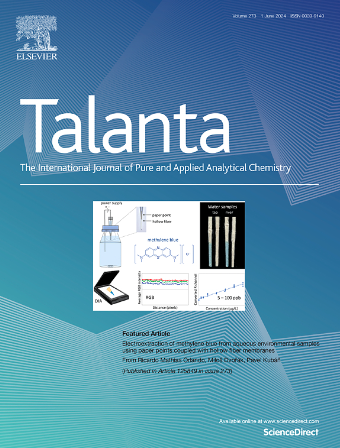利用部分填充双手性选择器系统的 CE-ESI/MS 研究外消旋氯胺酮及其 (S) 对映异构体在大鼠血浆中的代谢途径
IF 5.6
1区 化学
Q1 CHEMISTRY, ANALYTICAL
引用次数: 0
摘要
本文章由计算机程序翻译,如有差异,请以英文原文为准。

Study of metabolic pathways of racemic ketamine and its (S)-enantiomer in rat blood plasma using CE-ESI/MS with partial filling of dual chiral selector system
Ketamine is a chiral drug used as anesthetic, analgesic and antidepressant. Its enantiomers and stereoisomers of its metabolites show different pharmacological and behavioral effects. To study the ketamine metabolic pathway and investigate these effects, highly sensitive and enantioselective methods are required. For that reason, in this study, a new CE method using a partial filling dual chiral selector system and ESI-MS detection has been developed and applied for separation and quantification of enantiomers of ketamine and its main metabolites, norketamine, hydroxynorketamine and dehydronorketamine, extracted by dichloromethane from the blood plasma of laboratory rats. The dual chiral selector system consisting of two zones of highly sulfated β-cyclodextrin (30 mg mL−1) and highly sulfated γ-cyclodextrin (10 mg mL−1) was introduced consecutively near the capillary outlet end. Both chiral selectors were dissolved in the background electrolyte composed of 10 mM ammonium hydroxide, 104 mM acetic acid, 10 % (v/v) ethanol, pH∗ 3.75. This system enabled enantioseparation of ketamine and its metabolites within a single CE run. High resolutions (3.99–17.61) of enantiomers of all above four analytes within a short time (11 min) were achieved in the fused silica capillary covalently coated with weakly negatively charged polyanionic copolymer (poly(acrylamide-co-sodium-2-acrylamido-2-methylpropanesulfonate), PAMAMPS). This coating minimized analyte sorption to the capillary and provided good repeatability of migration times. The limits of detection and quantification of the above analytes were in the range 108–238 nM and 361–792 nM, respectively. The method was linear within wide concentration range of 0.1–200 μM and the recovery was 91.3–105 %.
求助全文
通过发布文献求助,成功后即可免费获取论文全文。
去求助
来源期刊

Talanta
化学-分析化学
CiteScore
12.30
自引率
4.90%
发文量
861
审稿时长
29 days
期刊介绍:
Talanta provides a forum for the publication of original research papers, short communications, and critical reviews in all branches of pure and applied analytical chemistry. Papers are evaluated based on established guidelines, including the fundamental nature of the study, scientific novelty, substantial improvement or advantage over existing technology or methods, and demonstrated analytical applicability. Original research papers on fundamental studies, and on novel sensor and instrumentation developments, are encouraged. Novel or improved applications in areas such as clinical and biological chemistry, environmental analysis, geochemistry, materials science and engineering, and analytical platforms for omics development are welcome.
Analytical performance of methods should be determined, including interference and matrix effects, and methods should be validated by comparison with a standard method, or analysis of a certified reference material. Simple spiking recoveries may not be sufficient. The developed method should especially comprise information on selectivity, sensitivity, detection limits, accuracy, and reliability. However, applying official validation or robustness studies to a routine method or technique does not necessarily constitute novelty. Proper statistical treatment of the data should be provided. Relevant literature should be cited, including related publications by the authors, and authors should discuss how their proposed methodology compares with previously reported methods.
 求助内容:
求助内容: 应助结果提醒方式:
应助结果提醒方式:


